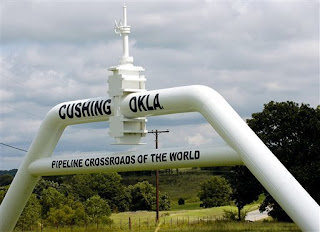
March 21, 2012
Ripped from tomorrow’s headlines….
Why is President Barack Obama going to Cushing, Oklahoma? What makes Cushing a pinpoint location for a discussion of the energy issues of our day? What twilight language is being served by this visit?
The answer rests squarely within the history of the site, and with a name very familiar to my research: Tom Slick.
On Wednesday, March 21, 2012, President Obama will fly into Cushing. The next morning, on Thursday, as part of an extended trip for his energy strategy, President Obama is scheduled to officially visit Cushing, Oklahoma, home to the world’s biggest oil storage complex. There he will tour a yard where TransCanada is storing pipes to be used in building the southern leg of the Keystone XL pipeline. The line will stretch from Cushing down to refineries on the Texas gulf coast.
What makes Cushing so special?
On St. Patrick’s Day 1912, Thomas “Dry Hole” or “Mad Tom” Slick (above) brought in the Wheeler No. 1 well about 12 miles east of Cushing, Oklahoma – the discovery well for the prolific Drumright-Cushing oilfield. The well produced for the next 35 years. At its peak, the oilfield would produce 330,000 barrels of oil a day.
Knowing that oilmen and speculators will descend on Cushing when the word gets out, Slick posts guards at his well – and takes other measures to protect his investment. How he does so is best described by a frustrated competing lease man (who was working for Harry Ford Sinclair; another competitor was John D. Milliken):
I got a call yesterday at the hotel in Cushing from a friend who said they had struck oil out there. A friend of his was listening in on the party line and heard the driller call Tom Slick at the farm where he’s been boarding and said they’d hit.
Well, I rushed down to the livery stable to get a rig to go out and do some leasing and damned if Slick hadn’t already been there and hired every rig. Not only there, but every other stable in town…Some other scouts had already gotten the wagons on the first farms I hit. Soon as I got one I beat it back to town to pick up a notary public to carry along with me to get leases – and damned if Slick hadn’t hired every notary in town, too.
After his success in Cushing, Slick began an incredible 18-year streak of drilling successful wells. By 1930 in the Oklahoma City field alone, he drilled 45 wells with the capacity to produce 200,000 barrels of oil daily. ”Dry Hole Slick” became known hereafter as “The King of the Wildcatters.”
About Loren Coleman
Loren Coleman is one of the world’s leading cryptozoologists, some say “the” leading living cryptozoologist. Certainly, he is acknowledged as the current living American researcher and writer who has most popularized cryptozoology in the late 20th and early 21st centuries.
Starting his fieldwork and investigations in 1960, after traveling and trekking extensively in pursuit of cryptozoological mysteries, Coleman began writing to share his experiences in 1969. An honorary member of Ivan T. Sanderson’s Society for the Investigation of the Unexplained in the 1970s, Coleman has been bestowed with similar honorary memberships of the North Idaho College Cryptozoology Club in 1983, and in subsequent years, that of the British Columbia Scientific Cryptozoology Club, CryptoSafari International, and other international organizations. He was also a Life Member and Benefactor of the International Society of Cryptozoology (now-defunct).
Loren Coleman’s daily blog, as a member of the Cryptomundo Team, served as an ongoing avenue of communication for the ever-growing body of cryptozoo news from 2005 through 2013. He returned as an infrequent contributor beginning Halloween week of 2015.
Coleman is the founder in 2003, and current director of the International Cryptozoology Museum in Portland, Maine.
Filed under Breaking News, CryptoZoo News, Tom Slick